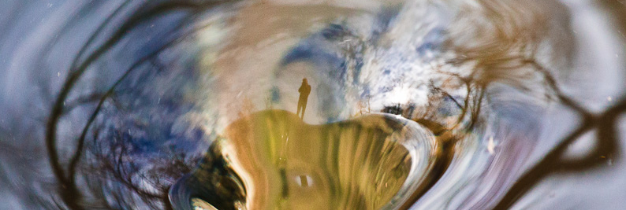
Anna Maria Johnson
Photography by Steven David Johnson
WhirlpoolsPhotography by Steven David Johnson
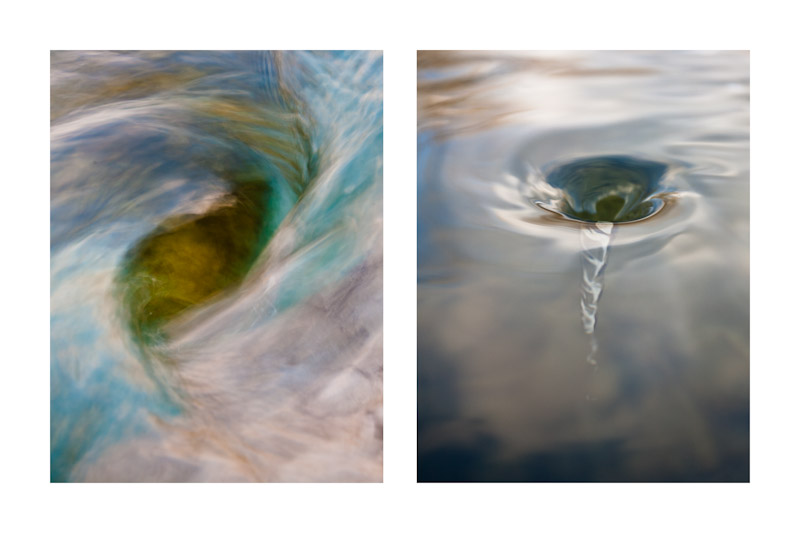
February 2011
The river today is flowing over the ford that crosses the Shenandoah’s North Fork where I live. Almost daily, I walk the length of my gravel driveway, cross the heavily trafficked Route 259, and traipse down to the river where the peaceful sound of flowing water balances the barrage of Jake brakes and car engines. From the ford, I can almost imagine away the highway. Today as I cross the ford, I notice that the water is about an inch or two deep in places, but along most of my path, the water’s just halfway up the tread of my shoes. If I’m careful, I can walk halfway across without getting my socks wet. Beneath the ford cylindrical tunnels allow water to flow through, and at each of them, on the upstream side, whirlpools sometimes collect. Today they are larger, more impressive than I’ve seen before: the diameter of one is about equal to the length of my arm from elbow to wrist. Must be just the right amount of water flow.
The river today is flowing over the ford that crosses the Shenandoah’s North Fork where I live. Almost daily, I walk the length of my gravel driveway, cross the heavily trafficked Route 259, and traipse down to the river where the peaceful sound of flowing water balances the barrage of Jake brakes and car engines. From the ford, I can almost imagine away the highway. Today as I cross the ford, I notice that the water is about an inch or two deep in places, but along most of my path, the water’s just halfway up the tread of my shoes. If I’m careful, I can walk halfway across without getting my socks wet. Beneath the ford cylindrical tunnels allow water to flow through, and at each of them, on the upstream side, whirlpools sometimes collect. Today they are larger, more impressive than I’ve seen before: the diameter of one is about equal to the length of my arm from elbow to wrist. Must be just the right amount of water flow.
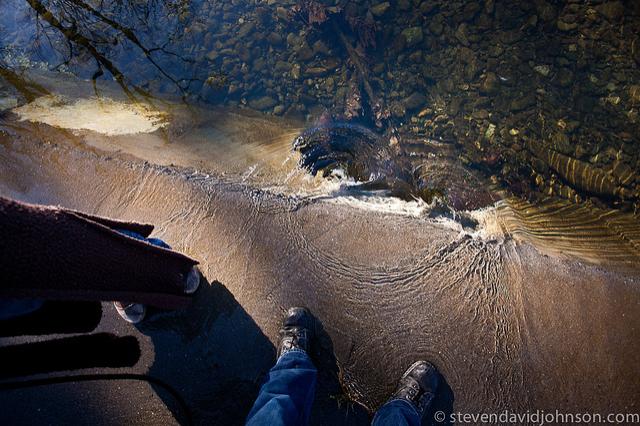
Sometimes a large, slender-funneled whirlpool widens, reaches a point of instability, a bifurcation point, and then divides into two spinning vortices. A parallelogram of ice, thin like an irregularly shaped sheet of glass, about the size of a windowpane, flows downstream toward the ford, and as soon as a corner of it touches the rim of the whirlpool, the ice is sucked down. Vanished.
My dog, Zuli, approaches a whirlpool to sniff at it, and after briefly investigating, backs away, refusing to go near it again. I imagine she has mentally filed “whirlpools” in the same category as “vacuum cleaners.”
I can’t say that I blame her. A childhood memory floats toward me like the ice. Huddled on a couch at a friend’s house, we’re watching a cartoon in which a character gets sucked down a whirlpool into a mysterious underwater world. Oddly, even in adulthood, when I see even a small whirlpool, the same tight feeling clamps across my chest, a feeling of awe and dread that such forces of nature exist—whirlpools, that is, if not underwater kingdoms.
The cartoon was perhaps all the more terrifying because before then, the only place I’d witnessed real-life whirlpools was in the bathtub. At the end of bath-time, my mother would flip the little metal drain switch and together we would wait for the whirlpool to appear, then grow larger and noisier, suuuuck!—until, suddenly, it disappeared down the grate, leaving me wondering what it had been and where it had gone. My mother reassured me it would come again next time we drained the tub, and that bathtub whirlpools were not strong enough to suck me down.
How strange it seemed that a thing could exist only in the process of being drained away. The whirlpool was never present while the tub was full and plugged, nor while the tub was empty, but only during those brief moments of transition, of being in between things, of being neither full nor empty. The very thing that made the whirlpool appear—the process of water draining—was also the thing that would ultimately destroy it.
Witnessing river whirlpools as an adult makes me interested in understanding the mathematics of how they work. I spent a day reading about the Fibonacci sequence, a recursive equation: in order to calculate the next number in the sequence, one simply adds the previous two. 1, 1, 2, 3, 5, 8, 13 . . . It’s related to the Greek notion of the golden section—a perfect ratio for making the most beautiful proportions in art.
Imagine taking graph paper and tracing one square, then another adjacent to it. Those two squares represent the first two 1s in the sequence. Next draw a square twice as big beside them, so that the first two unit squares together form one side of the new double-sized square, and each side of the new square is as long as two graph paper boxes. The new square represents the number 2 in the Fibonacci sequence. Next draw a square of length 3, so that one of its sides is shared with both one side of the first unit square plus a side of the double-sized square. If you want to draw yet another square, one side of this one will share a side with the previous square (with sides of length 3) plus the original two unit-squares; this latest square will have a length equal to five graph paper boxes. Draw the next square such that it adjoins the square of length 5, plus one of the first unit squares, as well as the square with length 2 (this will produce a square with each side as long as 8 graph paper boxes). The following square will have length 13 and adjoin the square of length 8, plus one side of the square with length 2, plus a side of the square with length 3. You could keep going to infinity, if you had an infinitely large sheet of graph paper. Since you probably don’t, though, you will have to stop sometime, most likely around the square with length 21. At that point, it will be fun to carefully draw a spiral that begins in one corner of the first little unit square, then curves elegantly through a corner of the square with length 3, then a corner of the square with length 5, then the corner of the square with length 8, and the corner of the square with length 13, and so on. The resulting curve, called a golden spiral, resembles a nautilus shell, or an elephant’s tusk, or a snail shell. Or the surface of a whirlpool.
The golden spiral is a logarithmic function of the number phi, which is sometimes also called mu. I spent another day looking at pictures of other things in nature that can be described in these mathematical terms—pine cones, pineapples, sunflower seed heads, spiral galaxies as viewed from earth.
That night, I tell my husband, Steven, what I’ve learned. We both wonder whether the images of the whirlpools, photographed as seen from above, will fit neatly into a golden spiral. Using computer software, over one of his whirlpool digital photographs, Steven overlays the “golden section” tool. The digital line drawing of the golden spiral fits perfectly over the image of the swirling water, almost as if the water had arranged itself using a graph paper pattern or digital tools.
That night, I tell my husband, Steven, what I’ve learned. We both wonder whether the images of the whirlpools, photographed as seen from above, will fit neatly into a golden spiral. Using computer software, over one of his whirlpool digital photographs, Steven overlays the “golden section” tool. The digital line drawing of the golden spiral fits perfectly over the image of the swirling water, almost as if the water had arranged itself using a graph paper pattern or digital tools.
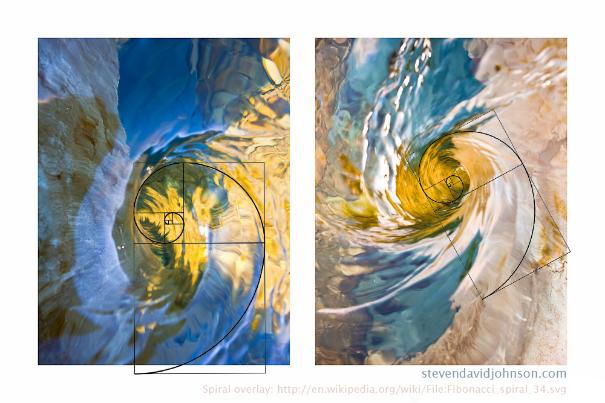
Steven has been enamored with whirlpools for some time now. He compares them to human beings because over time, cells flow into our bodies and out again, so that every few years our bodies, though they adhere to the same pattern of DNA and look about the same from year to year, come to be made up of almost entirely different building blocks. In the same way, he says, water molecules enter the whirlpool and then swirl out. The whirlpool still resembles itself, but every few seconds its molecules are replaced by entirely new ones. The parts are all different, but the whole is still a whirlpool.
Fritjof Capra, in his book The Web of Life, refers to whirlpools as a type of “dissipative structures” because the elements that make them continually dissipate, even as the structure itself remains relatively stable. Metaphorically, Capra says, a biological cell can also be compared to a whirlpool. It continually draws nutrients into itself, then sends out waste: by this process a cell, never static, continually makes itself.
The whirlpool is essentially a pattern. Our bodies, too—that which we think of as our selves—are more pattern than static constant. This idea is visually represented in a video of a man named Noah Kalina, who has photographed himself daily since January 11, 2000. After the first six years, he compiled all the daily images into one six-minute digital film, which Time Magazine named as one of YouTube’s Top 50 videos. In the video, Noah’s eyes remain locked straight ahead while all around him, his environment swirls and flickers with change. His hair whips about like seaweed in waves, the room in the background shifts as the furniture moves, the light around him brightens and dulls, his face ages. Yet Noah’s eyes—the windows to the soul, so the cliché goes—remain constant. Noah remains himself. Between the first image of Noah and the last, most of his body’s cells were replaced—skin, hair, nails, digestive track, even bone . . . although not many of his brain and nerve cells turned over, as those apparently don’t replace themselves except in the hippocampus and a few other regions. Liver cells, we believe, reproduce only when injured. Noah’s heart, too, would have remained almost constant, as hearts regenerate slowly, possibly just once over the course of a lifetime.
Back on the North Fork, after a period of dry weather, the water level sinks beneath the ford and the whirlpools disappear as water flows smoothly through the cylindrical pipes below. But come heavy rains, the ford floods, then the waters recede slowly, forming, for a couple of days, new whirlpools.
As we stand together on the ford on a late spring evening, Steven wonders whether we, like whirlpools, can be reconstituted even after we disappear. He muses that maybe resurrection works like that: that somehow, mysteriously, God keeps the patterns of all living things and might one day, after their deaths, reconstitute their bodies. Part of me wishes I could believe this is so, but another part resists; a living structure is so much richer, more complex, more specific, and seemingly irreversible than a simple whirlpool. Perhaps life would seem too expendable, no longer unique, if it could be made the same again. Yet, I would pay any price to see, for example, a Dodo bird brought back from extinction.
Fritjof Capra, in his book The Web of Life, refers to whirlpools as a type of “dissipative structures” because the elements that make them continually dissipate, even as the structure itself remains relatively stable. Metaphorically, Capra says, a biological cell can also be compared to a whirlpool. It continually draws nutrients into itself, then sends out waste: by this process a cell, never static, continually makes itself.
The whirlpool is essentially a pattern. Our bodies, too—that which we think of as our selves—are more pattern than static constant. This idea is visually represented in a video of a man named Noah Kalina, who has photographed himself daily since January 11, 2000. After the first six years, he compiled all the daily images into one six-minute digital film, which Time Magazine named as one of YouTube’s Top 50 videos. In the video, Noah’s eyes remain locked straight ahead while all around him, his environment swirls and flickers with change. His hair whips about like seaweed in waves, the room in the background shifts as the furniture moves, the light around him brightens and dulls, his face ages. Yet Noah’s eyes—the windows to the soul, so the cliché goes—remain constant. Noah remains himself. Between the first image of Noah and the last, most of his body’s cells were replaced—skin, hair, nails, digestive track, even bone . . . although not many of his brain and nerve cells turned over, as those apparently don’t replace themselves except in the hippocampus and a few other regions. Liver cells, we believe, reproduce only when injured. Noah’s heart, too, would have remained almost constant, as hearts regenerate slowly, possibly just once over the course of a lifetime.
***
Back on the North Fork, after a period of dry weather, the water level sinks beneath the ford and the whirlpools disappear as water flows smoothly through the cylindrical pipes below. But come heavy rains, the ford floods, then the waters recede slowly, forming, for a couple of days, new whirlpools.
As we stand together on the ford on a late spring evening, Steven wonders whether we, like whirlpools, can be reconstituted even after we disappear. He muses that maybe resurrection works like that: that somehow, mysteriously, God keeps the patterns of all living things and might one day, after their deaths, reconstitute their bodies. Part of me wishes I could believe this is so, but another part resists; a living structure is so much richer, more complex, more specific, and seemingly irreversible than a simple whirlpool. Perhaps life would seem too expendable, no longer unique, if it could be made the same again. Yet, I would pay any price to see, for example, a Dodo bird brought back from extinction.
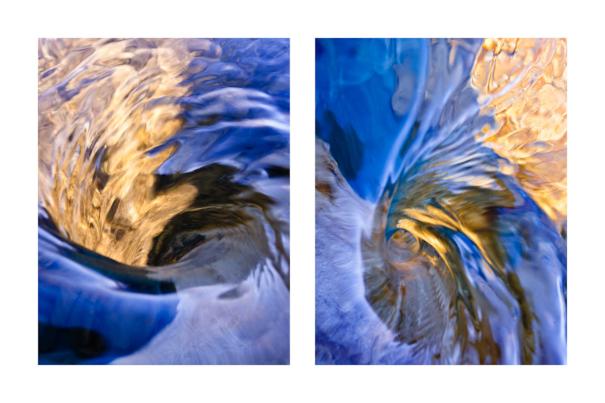
After an earthquake and subsequent tsunami hit Honshu Island in Japan, I returned to the ford near our home, where whirlpools had again formed along the edges, where I stood watching them and tried to absorb the global news. Steven made a video of our whirlpools, which he layered with a soundtrack of an audio collaboration between spoken word artist Erin Dingle, and electronic musician Lokey—part of the Monome Community, “an eclectic collective of electronic artists” which came together in response to the recent natural disasters, including the one the tsunami they call Tohoku Chiho Taiheiyo-oki Jishin. It seemed quite natural that artists, musicians, and poets from different parts of the world would wind up collaborating on a response to the shock we all felt upon learning the news from Japan.
Online, I watch astronomical videos of black holes swirling like unfathomable whirlpools, joining and breaking apart with the same kind of exchanges of energy scientists think created our solar system, our earth. Is it thinkable that the dark forces that are capable of sucking all matter into themselves are the same as the forces that give birth to life? Is this really where we all came from, the origin of every living thing I know? The scientists of today, who theorize that all we know arose out of the energy released by two black holes colliding, sound remarkably like ancient and medieval philosophers and mystics. Plotinus believed that life began from a whirlpool and returns to it after death. The Taoist book Huai Nan Tzu (second-century BCE), says, “before the heavens and the earth took shape, there was an abyss without form and void, the Supreme Light. The Tao began with Emptiness and the Emptiness produced the universe. The universe produced the ch’I [the vital breath] and it was like a whirlpool swirling between two banks.”
A Hindu acquaintance was explaining to me recently what it means to worship Shiva, the god of both destruction and of rebirth. It seems to me now that it is a little like watching whirlpools collide and re-form.
My dog, Zuli, and I have come down to the river to find whirlpools again. One in particular makes a strong sucking sound as we approach. I try to imitate it by rolling my tongue onto my mouth’s roof and sucking air. I don’t have nearly the sustaining power that the whirlpool has, but I imagine the invisible air eddying around my lips in whirling pools no one can see. I listen to the sound of the whirlpool, erratic, sputtering when it sucks leaves into itself, then continuing its peculiar, haunting song.
Online, I watch astronomical videos of black holes swirling like unfathomable whirlpools, joining and breaking apart with the same kind of exchanges of energy scientists think created our solar system, our earth. Is it thinkable that the dark forces that are capable of sucking all matter into themselves are the same as the forces that give birth to life? Is this really where we all came from, the origin of every living thing I know? The scientists of today, who theorize that all we know arose out of the energy released by two black holes colliding, sound remarkably like ancient and medieval philosophers and mystics. Plotinus believed that life began from a whirlpool and returns to it after death. The Taoist book Huai Nan Tzu (second-century BCE), says, “before the heavens and the earth took shape, there was an abyss without form and void, the Supreme Light. The Tao began with Emptiness and the Emptiness produced the universe. The universe produced the ch’I [the vital breath] and it was like a whirlpool swirling between two banks.”
A Hindu acquaintance was explaining to me recently what it means to worship Shiva, the god of both destruction and of rebirth. It seems to me now that it is a little like watching whirlpools collide and re-form.
***
My dog, Zuli, and I have come down to the river to find whirlpools again. One in particular makes a strong sucking sound as we approach. I try to imitate it by rolling my tongue onto my mouth’s roof and sucking air. I don’t have nearly the sustaining power that the whirlpool has, but I imagine the invisible air eddying around my lips in whirling pools no one can see. I listen to the sound of the whirlpool, erratic, sputtering when it sucks leaves into itself, then continuing its peculiar, haunting song.
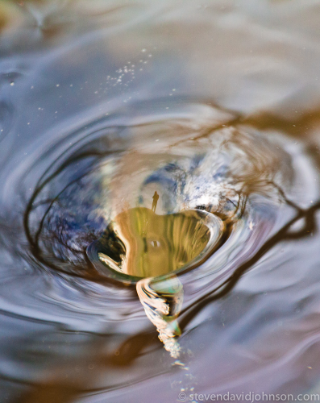
Some of the images and portions of the text appeared in different form at Numero Cinq